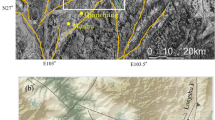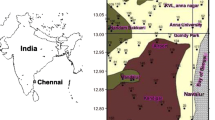Abstract
This study provides an engineering-focused assessment of the ground motions recorded during the \({M}_\mathrm{w}\) 7.2 reverse-slip Van earthquake. Spatial and temporal distributions of the site responses and their effects on the structural responses were discussed. Reverse/oblique earthquake characteristics with coupled effects of source, path of propagation and local site conditions in the fault-normal and fault-parallel directions on hanging wall and footwall blocks are particularly considered. Magnitude and distance dependency of the recordings from 22 stations were examined using ground motion prediction equations developed for reverse mechanism. Results show that parameters in the ground motion prediction expressions are not robust enough to represent the source process and propagation effects. Elastic and inelastic displacement limits for the first three closest stations are exceeded in each direction for structural periods greater than about 0.2 s. Severely damaged towns Erciş and Van were examined in the lights of available recordings. Large structural displacement responses of the majority of the buildings initiated inelastic behavior during the main shock. As a consequence of severe demands, structural collapses observed at the region due to poor construction quality which satisfied neither nominal nor full ductility levels. Overall results indicated that effects of directivity and hanging wall effect increased the influence of the seismic loading on structures despite low peak acceleration values recorded at the region. For known active tectonic regions, earthquake design spectrum should be modified over a period range of interest for rupture dynamics and near-fault ground motions in strike-normal and strike-parallel directions.
Similar content being viewed by others
References
Koçyiğit, A.: New field and seismic data about the intraplate strike-slip deformation in Van region, East Anatolian Plateau, E Turkey. J. Asian Earth Sci. 62, 586–605 (2013)
Beyen, K.; Tanırcan, G.: Strong motion characteristics of the 2011 Van earthquake of Turkey: implications of seismological aspects on engineering parameters. Earthq. Struct. 8(6), 1363–1386 (2015)
Çoşkan, S.; Kartal, M.E.; Bilir, T.: The effect of concrete strengths obtained from 2011 Van earthquake on the structural performance of RC buildings. Arab. J. Sci. Eng. 41, 3817–3825 (2016)
Ilki, A.; Celep, Z.: Earthquakes, existing buildings and seismic design codes in Turkey. Arab. J. Sci. Eng. 37, 365–380 (2012)
Ozden, S.: Performance of precast concrete structures in October 2011 Van earthquake, Turkey. Mag. Concr. Res. 66(11), 543–552 (2014)
Tapan, M.; Comert, M.; Demir, C.; Sayan, Y.; Orakcal, K.; Ilki, A.: Failures of structures during the October 23, 2011 Tabanlı (Van) and November 9, 2011 Edremit (Van) earthquakes in Turkey. Eng. Fail. Anal. 34, 606–628 (2013)
Akansel, V.; Ameri, G.; Askan, A.; Caner, A.; Erdil, B.; Kale, Ö.; Okuyucu, D.: The 23 October 2011 Mw 7.0 Van (Eastern Turkey) earthquake: interpretations of recorded strong ground motions and post earthquake conditions of nearby structures. Eq. Spectra 30, 657–682 (2013)
Taskin, B.; Sezen, A.; Tugsal, U.M.; Erken, A.: The aftermath of 2011 Van earthquakes: evaluation of strong motion, geotechnical and structural issues. Bull. Earthq. Eng. 11(1), 285–312 (2013)
Taymaz, T.; Yilmaz, Y.; Dilek, Y.: The Geodynamics of the Aegean and Anatolia: Introduction, vol. 291, pp. 1–16. Special PublicationsGeological Society, London (2007)
Barka, A.A.; Reilinger, R.: Active tectonics of the Eastern Mediterranean Region: deduced from GPS, neotectonic and seismicity data. Ann. Geophys. 40(3) (1997). https://doi.org/10.4401/ag-3892
Mc Clusky, S.; Balassanian, S.; Barka, A.; et al.: GPS constraints on plate kinematics and dynamics in the Eastern Mediterranean and Caucasus. J. Geophys. Res. Atmos. 105(B3), 5695–5719 (2000)
Doğan, B.; Karakaş, A.: Geometry of co-seismic surface ruptures and tectonic meaning of the 23 October 2011 \(\text{ M }_{{\rm w}}\) 7.1 Van earthquake (East Anatolian Region, Turkey). J. Struct. Geol. 46, 99–114 (2013)
Elliot, J.R.; Copley, A.C.; Holley, R.; Scharer, K.; Parsons, B.: The 2011 \(\text{ M }_{{\rm w}}\) 7.1 Van (Eastern Turkey) Earthquake. J. Geophys. Res. Solid Earth 118, 1–19 (2013)
Kalafat, D.; Güneş, Y.; Kekovalı, K.: 2 Jully 2004 Doğubayazıt (Karaköse-Ağrı) earthquake, preliminary field report. Council of Europe, EMSC European Mediterranean Seismological Centre, Special web pages on significant earthquakes. www.emsc-csem.org (2004). Accessed 11 Sept 2018
Kalafat, D.; Kekovalı, K.; Güneş, Y.; Küsmezer, A.; Garip P.; Berberoğlu, A.; Bekler, F.: 25 January 2005 Hakkari Earthquake report. Council of Europe, EMSC European Mediterranean Seismological Centre, Special web pages on significant earthquakes. www.emsc-csem.org (2005). Accessed 11 Sept 2018
Taymaz, T.; Eyidoğan, H.; Jackson, J.: Source parameters of large earthquakes in the East Anatolian fault zone (Turkey). Geophys. J. Int. 106, 537–550 (1991). Oxford
Gülkan, P.; Gürpınar, A.; Celebi, M.; Arpat, E.; Gencoglu, S.: Engineering Report on the Muradiye–Çaldıran, Turkey, Earthquake of 24 November 1976. National Academy of Sciences, Washington (1978)
Gökkaya, K.: Geographic analysis of earthquake damage in Turkey between 1900 and 2012. Geomat. Nat. Hazards Risk 7(6), 1948–1961 (2016)
AFAD: Deprem Dairesi Başkanlığı. http://www.deprem.gov.tr (2011). Accessed 11 Sept 2018
KOERI:http://www.koeri.boun.edu.tr/Publications/OCTOBER%2023,%202011%20VAN%20EARTHQUAKE_14_262.depmuh (2011). Accessed 11 Sept 2018
NERA: Analysis of relative contribution of source, scattering and local site effects to ground motion, Network of European Research Infrastructures for Earthquake Risk Assessment and Mitigation, Project in JRA3—Work Package, EC Project number: 262330 (2013)
Konagai, K.; Ulusay, R.; Kumsar, H.; Aydan, Ö.; Çelebi, M.: The characteristics of seismic, strong motion and structural damage of the 2011Van-Erciş earthquake. In: Proceedings of the International Symposium on Engineering Lessons Learned from the 2011 Great East Japan Earthquake, pp. 1902–1913, Tokyo, 1–4 Mar 2012
MATLAB 8.2: The MathWorks Inc., Natick, MA (2008)
Spudich, P.; Joyner, W.B.; Lindh, A.G.; Boore, D.M.; Margaris, B.M.; Fletcher, J.: B: SEA99: a revised ground motion prediction relation for use in extensional tectonic regimes. BSSA 89(5), 1156–1170 (1999)
Abrahamson, N.A.: Effects of rupture directivity on probabilistic seismic hazard analyses. In: Proceedings of the Sixth International Conference on Seismic Zonation, Earthquake Engineering Research Institute, Palm Springs, pp. 151–156 (2000)
Abrahamson, N.A.; Silva, W.J.: Summary of the Abrahamson & Silva NGA ground-motion relations. Earthq. Spectra 24(1), 67–97 (2008)
Boore, D.M.; Atkinson, G.M.: Ground-motion prediction equations for the average horizontal component of PGA, PGV, and 5% damped PSA at spectral periods between 0.01s and 10.0s. Earthq. Spectra 24(1), 99–138 (2008)
Campbell, K.W.; Bozorgnia, Y.: NGA ground motion model for the geometric mean horizontal component of PGA, PGV, PGD and 5% damped linear elastic response spectra for periods ranging from 0.01 to 10s. Earthq. Spectra 24(1), 139–171 (2008)
Chiou, B.S.J.; Youngs, R.R.: NGA ground motion relations for the geometric mean horizontal component of peak and spectral ground motion parameters. Earthq. Spectra 24(1), 173–215 (2008)
McVerry, G.H.; Zhao, J.X.; Abrahamson, N. A.; Somerville, P. G.: Crustal and subduction zone attenuation relations for New Zealand earthquakes. In: Proceedings of 12th World Conference on Earthquake Engineering, Paper No. 1834, Auckland (2000)
Field, E.H.; Jordan, T.H.; Cornell, C.A.: OpenSHA: a developing community-modeling environment for seismic hazard analysis. Seismol. Res. Lett. 74(4), 406–419 (2003)
Shabestari, Khosrowi T.; Yamazaki, F.: Near-fault spatial variation in strong ground motion due to rupture directivity and hanging wall effects from the Chi–Chi, Taiwan earthquake. Earthq. Eng. Struct. Dyn. 32, 2197–2219 (2003)
TEC: Ministry of public works and settlement, Specification for structures to be built in disaster areas, Republic of Turkey (2007)
Fajfar, P.: A nonlinear analysis method for performance based seismic design. Earthq. Spectra 16(3), 573–592 (2000)
Ulusay, R.; Kumsar, H.; Konagai, K.; Aydan, Ö.: The characteristics of geotechnical damage by the 2011 Van-Erciş earthquake. In: Proceedings of the International Symposium on Engineering Lessons Learned from the 2011 Great East Japan Earthquake, Tokyo (2012)
Somerville, P.G.; Smith, N.F.; Graves, R.W.; Abrahamson, N.A.: Modification of empirical strong ground-motion attenuation relations to include the amplitude and duration effect of rupture directivity. Seismol. Res. Lett. 68(1), 199–222 (1997)
Chopra, A.K.; Chintanapakde, C.: Comparing response of SDF systems to near-fault and far-fault earthquake motions in the context of spectral regions. Earthq. Eng. Soil Dyn. 30, 1769–1789 (2001)
Akkar, S.; Yazgan, U.; Gulkan, P.: Drift estimates in frame buildings subjected to near-fault ground motions. J. Struct. Eng. 131(7), 1014–1024 (2005)
Champion, C.; Liel, A.: The effect of near-fault directivity on building seismic collapse risk. Earthq. Eng. Struct. Dyn. 41, 1391–1409 (2012)
Somerville, P.G.: Magnitude scaling of the near fault rupture directivity pulse. Phys. Earth Planet. Inter. 137, 201–212 (2003)
Kunnath, S.K.; Abrahamson, N.; Chai, Y.H.; Erduran, E.; Yilmaz, Z.: Development of guidelines for incorporation of vertical ground motion effects in seismic design of highway bridges. Technical report CA/UCD-SESM-08-01 (2008)
Author information
Authors and Affiliations
Corresponding author
Rights and permissions
About this article
Cite this article
Beyen, K. Hanging Wall and Footwall Effects in the Largest Reverse-Slip Earthquake of Turkey, October 23, 2011, \({M}_{\mathrm{W}}\) 7.2 Van Earthquake. Arab J Sci Eng 44, 4757–4781 (2019). https://doi.org/10.1007/s13369-018-3547-x
Received:
Accepted:
Published:
Issue Date:
DOI: https://doi.org/10.1007/s13369-018-3547-x




